Microwave Staring Correlated Imaging Method Based on Steady Radiation Fields Sequence
Abstract
1. Introduction
2. Formulation of MSCI and the Defects Caused by Errors
2.1. Formulation of MSCI
2.2. Imaging Performance of MSCI Based on Matrix Perturbation Theory
2.3. Defects in MSCI with Random Frequency-Hopping Waveforms
- (1)
- Simulation and computation of unperturbed radiation fields without modeling errors: With the predesigns of the waveform parameters and geometric configuration, simulate the unperturbed radiation fields according to wave propagation procedure and obtain computation results of unperturbed radiation fields according to (4).
- (2)
- Simulation of actual radiation fields with the existence of modeling errors: According to the prior information about modeling errors, obtain actual values of the waveform parameters and geometric configuration, and make revisions on (1) and (2). Then, recompute the radiation fields according to wave propagation procedure according to (4) with the revised (1) and (2).
- (3)
- Simulation of actual scattering echoes with the existence of modeling errors: With the interaction of radiation fields and the given imaging target, the actual scattering echoes are obtained according to (3).
- (4)
- (5)
- Change the types and magnitudes of the modeling errors and obtain corresponding imaging results to demonstrate the detailed influences of diverse kinds of modeling errors.
3. MSCI Based on Steady Radiation Fields Sequence
3.1. System Design of Steady-Radiation-Fields-Sequence-Based MSCI
3.2. Waveform Design and Array Configuration Optimization of the Proposed SRFS-MSCI
- (1)
- Initial: The initial element position configuration is selected as a uniform 2D array. The elements of the initial amplitude matrix are set to a same value , i.e., constant power excitations. Randomly select a phase matrix from the available phase set .
- (2)
- Set from , from , and from by repeating the following operations J times: randomly select m from , n from , and from , from , set , . Change the position of the n-th transmitter in the given array with the distance of arbitrary two antennas satisfying .
- (3)
- Compute the imaging matrix by (6), and calculate the objective function .
- (4)
- Select a random value from . If , assign , and . Else, keep the , , and unchanged.
- (5)
- Set .
- (6)
- If T equals to the ended temperature , or the condition number of imaging matrix is nearly unchanged, terminate the iteration and output the optimized array configuration , amplitude matrix , and phase matrix . Else, go to Step (2).
4. Results and Discussion
4.1. Imaging of SRFS-MSCI with Optimized Parameters
4.2. Imaging Experiment of SRFS-MSCI in Microwave Anechoic Chamber
5. Conclusions
Author Contributions
Funding
Conflicts of Interest
Abbreviations
| MSCI | Microwave Staring Correlated Imaging |
| GI | Ghost Imaging |
| TSSRF | Temporal Spatial Stochastic Radiation Fields |
| CP | Correlation Process |
| SAR | Synthetic Aperture Radar |
| ISAR | Inverse Synthetic Aperture Radar |
| RRS | Random Radiation Source |
| FH | Frequency-Hopping |
| TSDE | Temporal-Spatial Distribution Entropy |
| SNR | Signal to Noise Ratio |
| SRFS-MSCI | Steady Radiation Fields Sequence based MSCI |
| SA | Simulated Annealing |
| RIE | Relative Imaging Error |
| RPE | Relative Perturbation Error |
| LO | Local Oscillator |
| DDS | Direct Digital Synthesis |
References
- Wei, Z.; Zhang, B.; Xu, Z.; Han, B.; Hong, W.; Wu, Y. An improved SAR imaging method based on nonconvex regularization and convex optimization. IEEE Geosci. Remote Sens. Lett. 2019, 16, 1580–1584. [Google Scholar] [CrossRef]
- Wu, Y.M.; Wu, A.W.; Jin, Y.Q.; Li, H. An Efficient Method on ISAR Image Reconstruction via Norm Regularization. IEEE J. Multiscale Multiphys. Comput. Tech. 2019, 4, 290–297. [Google Scholar] [CrossRef]
- Xiong, J.; Wang, W.Q.; Gao, K. FDA-MIMO radar range-angle estimation: CRLB, MSE, and resolution analysis. IEEE Trans. Aerosp. Electron. Syst. 2017, 54, 284–294. [Google Scholar] [CrossRef]
- Fedeli, A.; Pastorino, M.; Ponti, C.; Randazzo, A.; Schettini, G. Through-the-Wall Microwave Imaging: Forward and Inverse Scattering Modeling. Sensors 2020, 20, 2865. [Google Scholar] [CrossRef] [PubMed]
- Guo, Q.; Li, Y.; Liang, X.; Dong, J.; Cheng, R. Through-the-Wall Image Reconstruction via Reweighted Total Variation and Prior Information in Radio Tomographic Imaging. IEEE Access 2020, 8, 40057–40066. [Google Scholar] [CrossRef]
- Mizrahi, M.; Holdengreber, E.; Schacham, S.E.; Farber, E.; Zalevsky, Z. Improving Radar’s Spatial Recognition: A Radar Scanning Method Based on Microwave Spatial Spectral Illumination. IEEE Microw. Mag. 2016, 17, 28–34. [Google Scholar] [CrossRef]
- Mizrahi, M.; Holdengreber, E.; Farber, E.; Zalevsky, Z. Frequency multiplexing spatial super-resolved sensing for RADAR applications. Microw. Opt. Technol. Lett. 2016, 58, 831–835. [Google Scholar] [CrossRef]
- He, X.; Liu, B.; Chai, S.; Wang, D. A novel approach of high spatial-resolution microwave staring imaging. In Proceedings of the 2013 Asia-Pacific Conference on Synthetic Aperture Radar (APSAR), Tsukuba, Japan, 23–27 September 2013; pp. 75–78. [Google Scholar]
- Li, D.; Li, X.; Qin, Y.; Cheng, Y.; Wang, H. Radar coincidence imaging: An instantaneous imaging technique with stochastic signals. IEEE Trans. Geosci. Remote Sens. 2013, 52, 2261–2277. [Google Scholar]
- Pittman, T.B.; Shih, Y.H.; Strekalov, D.V.; Sergienko, A.V. Optical imaging by means of two-photon quantum entanglement. Phys. Rev. A 1995, 52, R3429–R3432. [Google Scholar] [CrossRef]
- Ferri, F.; Magatti, D.; Sala, V.G.; Gatti, A. Longitudinal coherence in thermal ghost imaging. Appl. Phys. Lett. 2008, 92, 261109. [Google Scholar] [CrossRef]
- Zhou, X.; Wang, H.; Cheng, Y.; Qin, Y. Off-grid radar coincidence imaging based on variational sparse Bayesian learning. Math. Probl. Eng. 2016, 2016. [Google Scholar] [CrossRef]
- Zhou, X.; Wang, H.; Cheng, Y.; Qin, Y. Radar coincidence imaging by exploiting the continuity of extended target. IET Radar Sonar Navig. 2016, 11, 60–69. [Google Scholar] [CrossRef]
- Wang, G.; Yuan, B.; Lu, G. Microwave staring correlated imaging via the combination of nonconvex low-rank and total variation regularization. In Proceedings of the Tenth International Conference on Digital Image Processing (ICDIP 2018), Shanghai, China, 11–14 May 2018; Volume 10806, p. 108063J. [Google Scholar]
- Cheng, Y.; Zhou, X.; Xu, X.; Qin, Y.; Wang, H. Radar coincidence imaging with stochastic frequency modulated array. IEEE J. Sel. Top. Signal Process. 2016, 11, 414–427. [Google Scholar] [CrossRef]
- Jiang, Z.; Guo, Y.; Deng, J.; Chen, W.; Wang, D. Microwave Staring Correlated Imaging Based on Unsteady Aerostat Platform. Sensors 2019, 19, 2825. [Google Scholar] [CrossRef]
- Jiang, Z.; Yuan, B.; Zhang, J.; Guo, Y.; Wang, D. Microwave Staring Correlated Imaging Based on Quasi-Stationary Platform with Motion Measurement Errors. Prog. Electromagn. Res. 2020, 97, 1–12. [Google Scholar] [CrossRef]
- Guo, Y.; He, X.; Wang, D. A novel super-resolution imaging method based on stochastic radiation radar array. Meas. Sci. Technol. 2013, 24, 074013. [Google Scholar] [CrossRef]
- Zhu, S.; Zhang, A.; Xu, Z.; Dong, X. Radar coincidence imaging with random microwave source. IEEE Antennas Wirel. Propag. Lett. 2015, 14, 1239–1242. [Google Scholar] [CrossRef]
- Guo, Y.; Wang, D.; He, X.; Liu, B. Super-resolution staring imaging radar based on stochastic radiation fields. In Proceedings of the 2012 IEEE MTT-S International Microwave Workshop Series on Millimeter Wave Wireless Technology and Applications, Nanjing, China, 18–20 September 2012. [Google Scholar]
- Zhou, X.; Wang, H.; Cheng, Y.; Qin, Y.; Chen, H. Radar coincidence imaging for off-grid target using frequency-hopping waveforms. Int. J. Antennas Propag. 2016, 2016. [Google Scholar] [CrossRef]
- Zha, G.; Wang, H.; Yang, Z.; Cheng, Y.; Qin, Y. Angular resolution limits for coincidence imaging radar based on correlation theory. In Proceedings of the 2015 IEEE International Conference on Signal Processing, Communications and Computing (ICSPCC), Ningbo, China, 19–22 September 2015. [Google Scholar]
- Tian, C.; Jiang, Z.; Chen, W.; Wang, D. Adaptive microwave staring correlated imaging for targets appearing in discrete clusters. Sensors 2017, 17, 2409. [Google Scholar] [CrossRef]
- Zhou, X.; Wang, H.; Cheng, Y.; Qin, Y.; Chen, H. Waveform Analysis and Optimization for Radar Coincidence Imaging with Modeling Error. Math. Probl. Eng. 2017, 2017. [Google Scholar] [CrossRef]
- Meng, Q.; Qian, T.; Yuan, B.; Wang, D. Random Radiation Source Optimization Method for Microwave Staring Correlated Imaging Based on Temporal-Spatial Relative Distribution Entropy. Prog. Electromagn. Res. 2018, 63, 195–206. [Google Scholar] [CrossRef]
- Yuan, B.; Guo, Y.; Chen, W.; Wang, D. A Novel Microwave Staring Correlated Radar Imaging Method Based on Bi-Static Radar System. Sensors 2019, 19, 879. [Google Scholar] [CrossRef] [PubMed]
- He, Y.; Zhu, S.; Dong, G.; Zhang, S.; Zhang, A.; Xu, Z. Resolution analysis of spatial modulation coincidence imaging based on reflective surface. IEEE Trans. Geosci. Remote Sens. 2018, 56, 3762–3771. [Google Scholar] [CrossRef]
- Liu, B.; Wang, D. Orthogonal radiation field construction for microwave staring correlated imaging. Prog. Electromagn. Res. 2017, 57, 139–149. [Google Scholar] [CrossRef]
- Zhou, X.; Wang, H.; Cheng, Y.; Qin, Y. Sparse auto-calibration for radar coincidence imaging with gain-phase errors. Sensors 2015, 15, 27611–27624. [Google Scholar] [CrossRef]
- Yuan, B.; Jiang, Z.; Zhang, J.; Guo, Y.; Wang, D. Sparse Self-Calibration for Microwave Staring Correlated Imaging with Random Phase Errors. Prog. Electromagn. Res. 2020, 105, 253–269. [Google Scholar] [CrossRef]
- Yuan, B.; Jiang, Z.; Zhang, J.; Guo, Y.; Wang, D. A Self-Calibration Imaging Method for Microwave Staring Correlated Imaging Radar with Time Synchronization Errors. IEEE Sens. J. 2020. [Google Scholar] [CrossRef]
- Tian, C.; Yuan, B.; Wang, D. Calibration of gain-phase and synchronization errors for microwave staring correlated imaging with frequency-hopping waveforms. In Proceedings of the 2018 IEEE Radar Conference (RadarConf18), Oklahoma City, OK, USA, 23–27 April 2018; pp. 1328–1333. [Google Scholar]
- Zhang, J.; Yuan, B.; Jiang, Z.; Guo, Y.; Wang, D. Microwave Staring Correlated Imaging Based on Time-Division Observation and Digital Waveform Synthesis. Electronics 2020, 9, 1627. [Google Scholar] [CrossRef]
- Kirkpatrick, S.; Gelatt, C.D.; Vecchi, M.P. Optimization by simulated annealing. Science 1983, 220, 671–680. [Google Scholar] [CrossRef]
- Doğu, S.; Akıncı, M.N.; Çayören, M.; Akduman, İ. Truncated singular value decomposition for through-the-wall microwave imaging application. IET Microw. Antennas Propag. 2019, 14, 260–267. [Google Scholar] [CrossRef]
- Strong, D.; Chan, T. Edge-preserving and scale-dependent properties of total variation regularization. Inverse Probl. 2003, 19, S165. [Google Scholar] [CrossRef]
- Li, C.; Yin, W.; Jiang, H.; Zhang, Y. An efficient augmented Lagrangian method with applications to total variation minimization. Comput. Optim. Appl. 2013, 56, 507–530. [Google Scholar] [CrossRef]


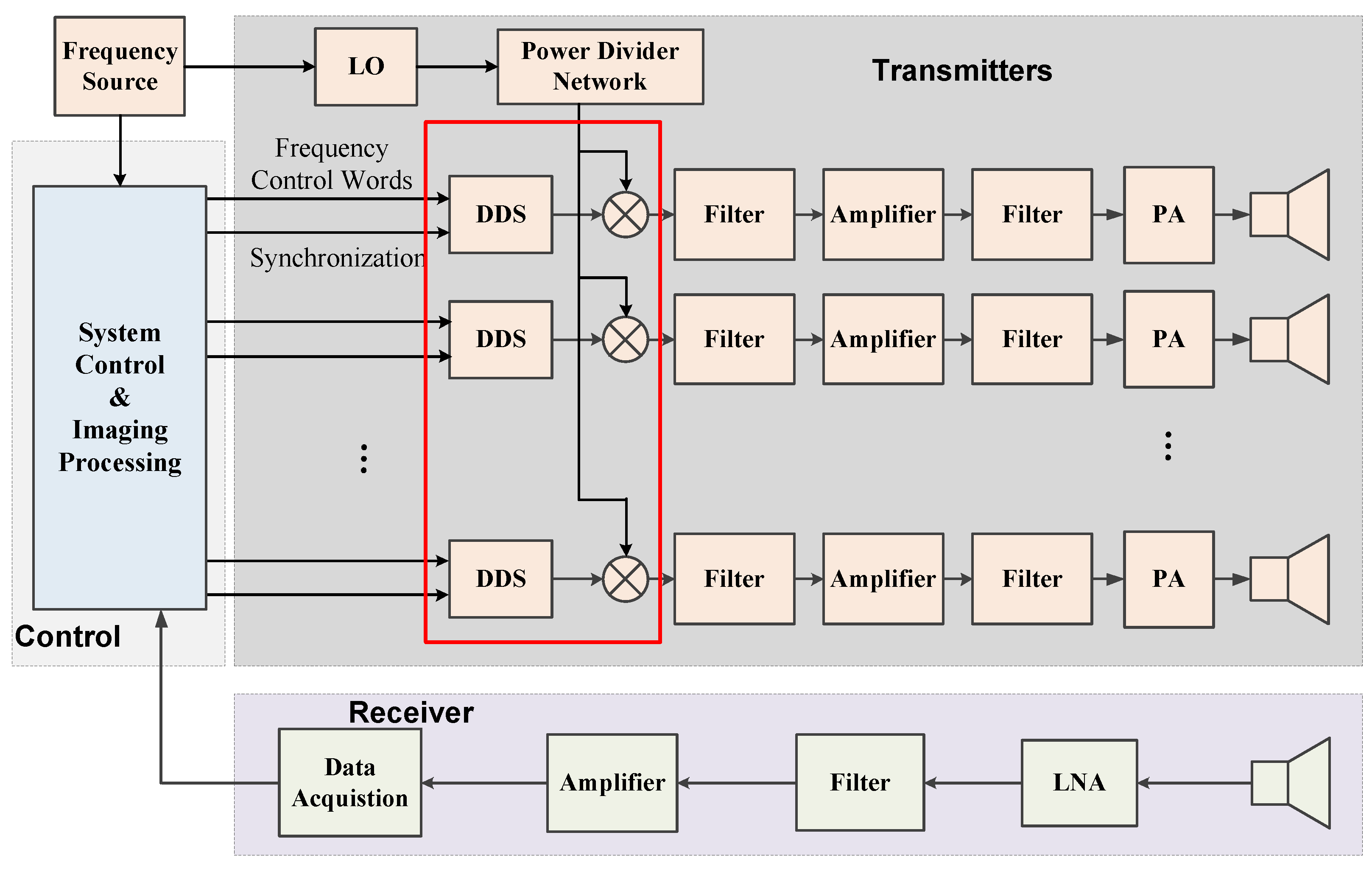
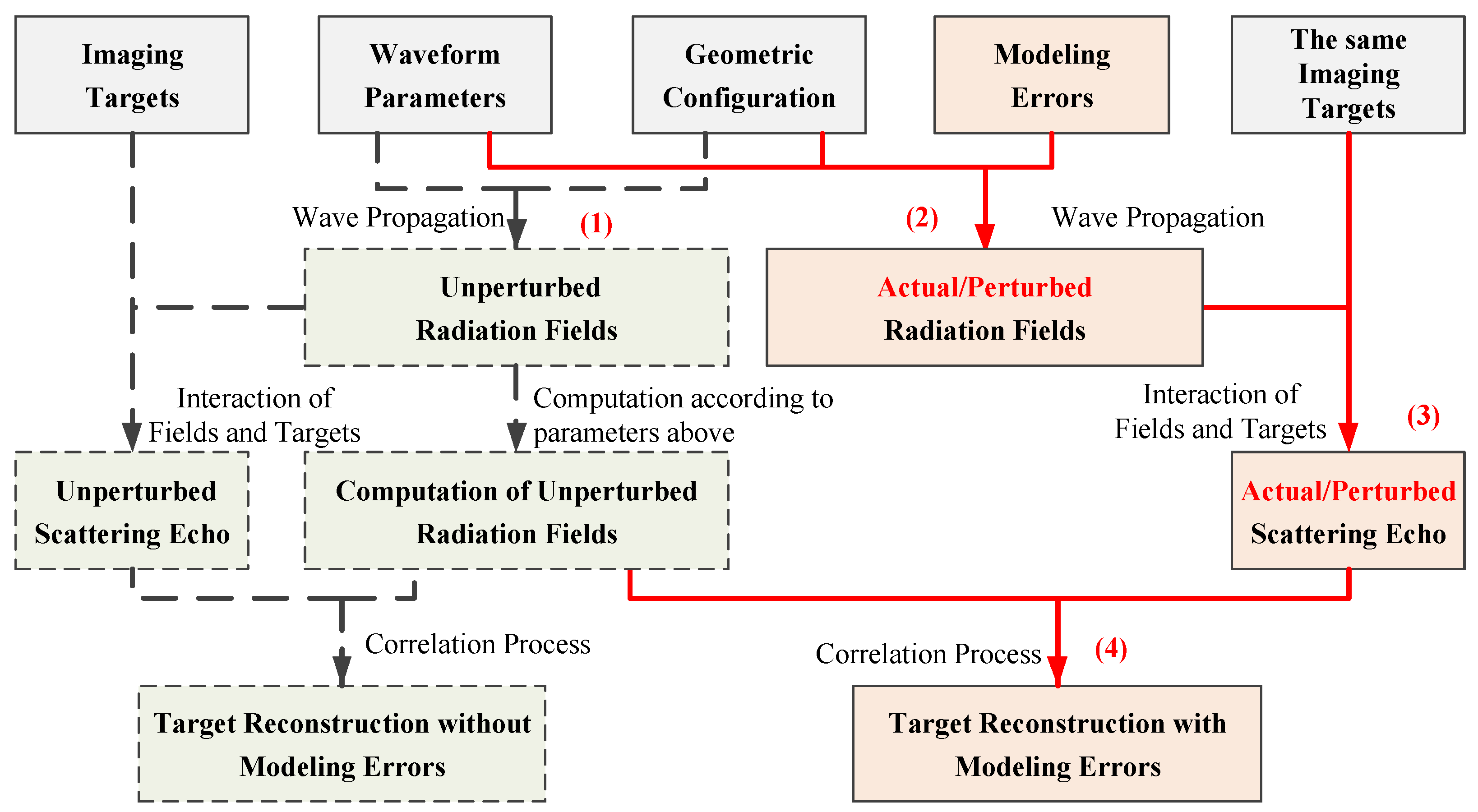


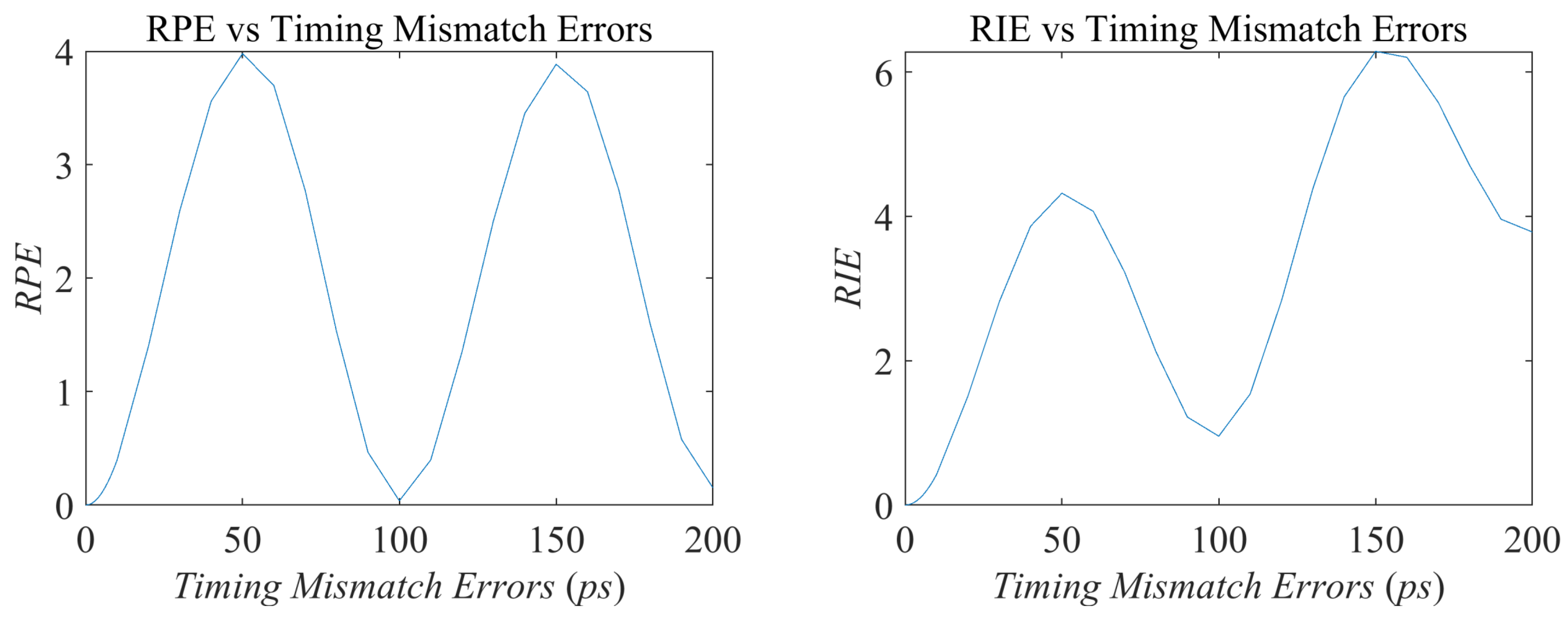


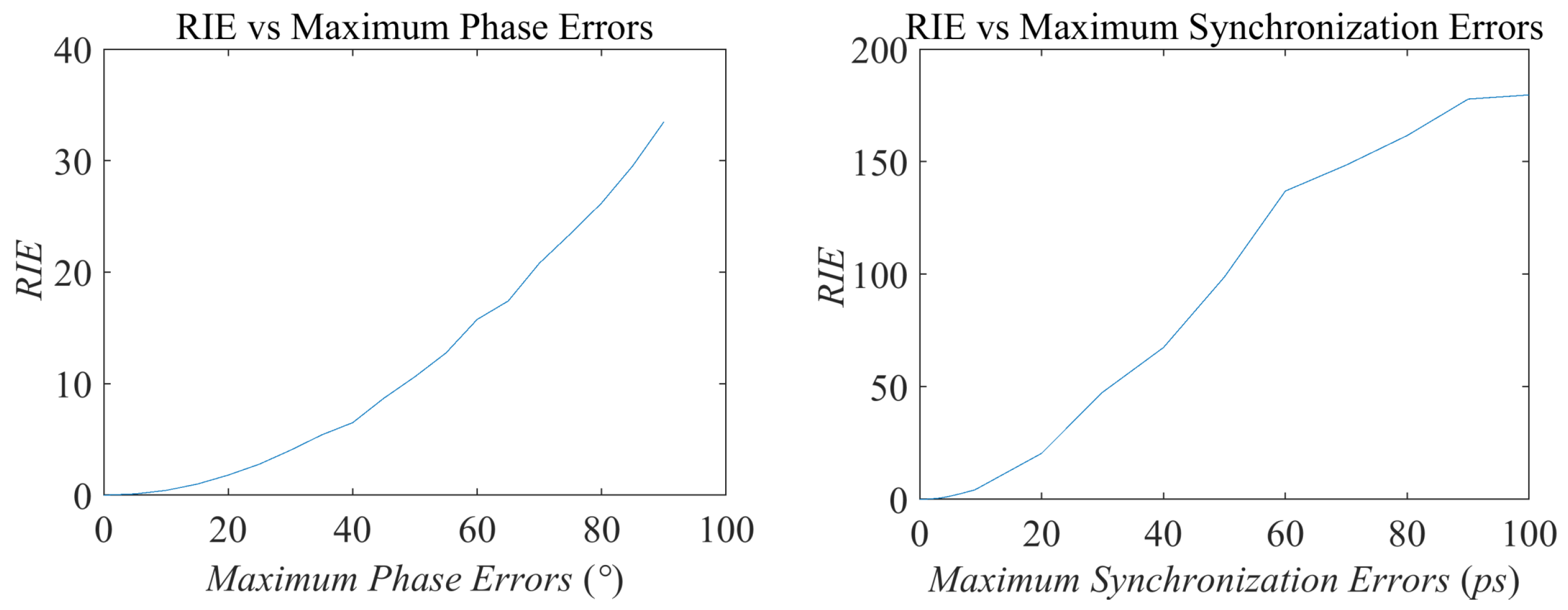
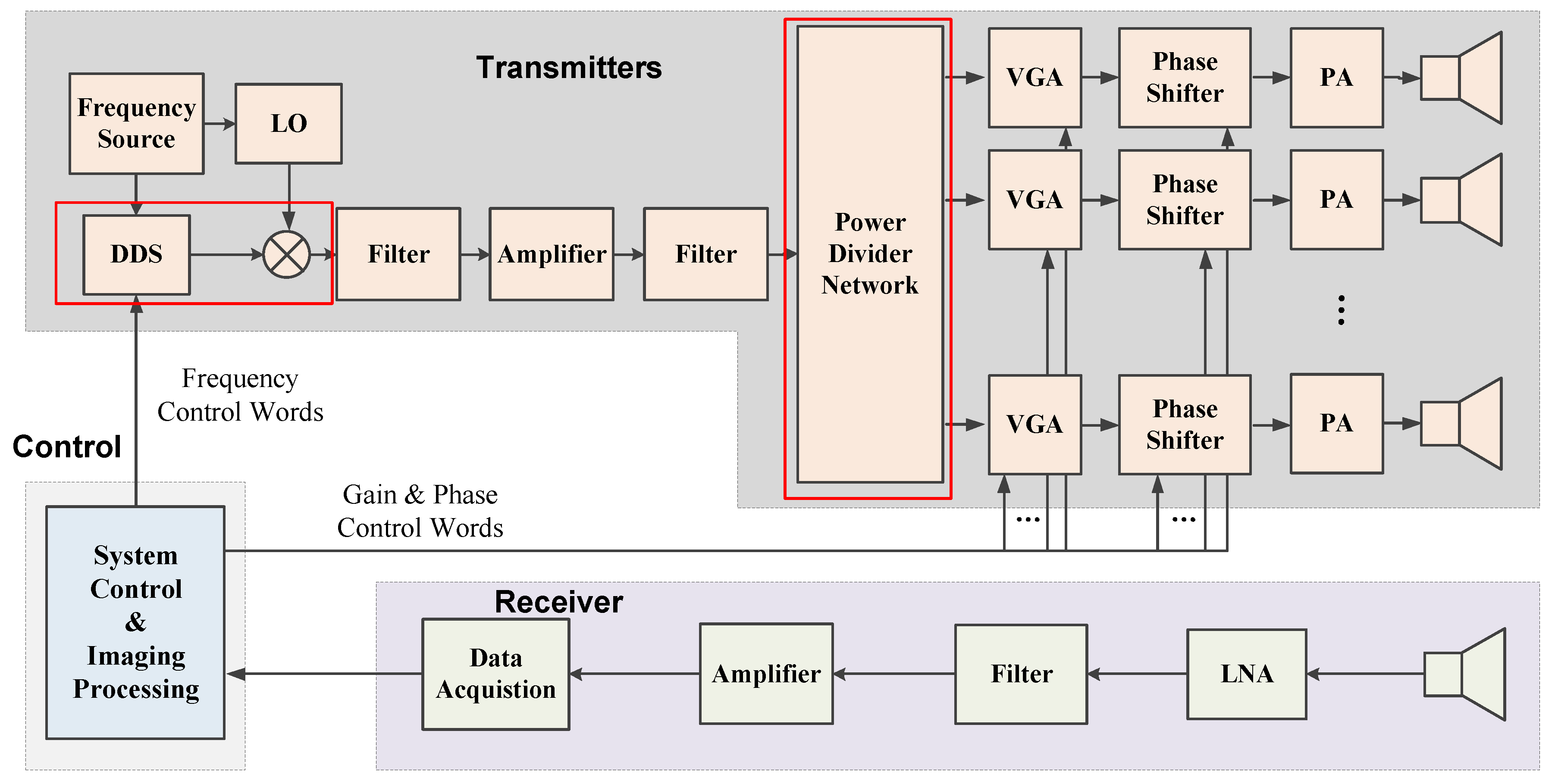

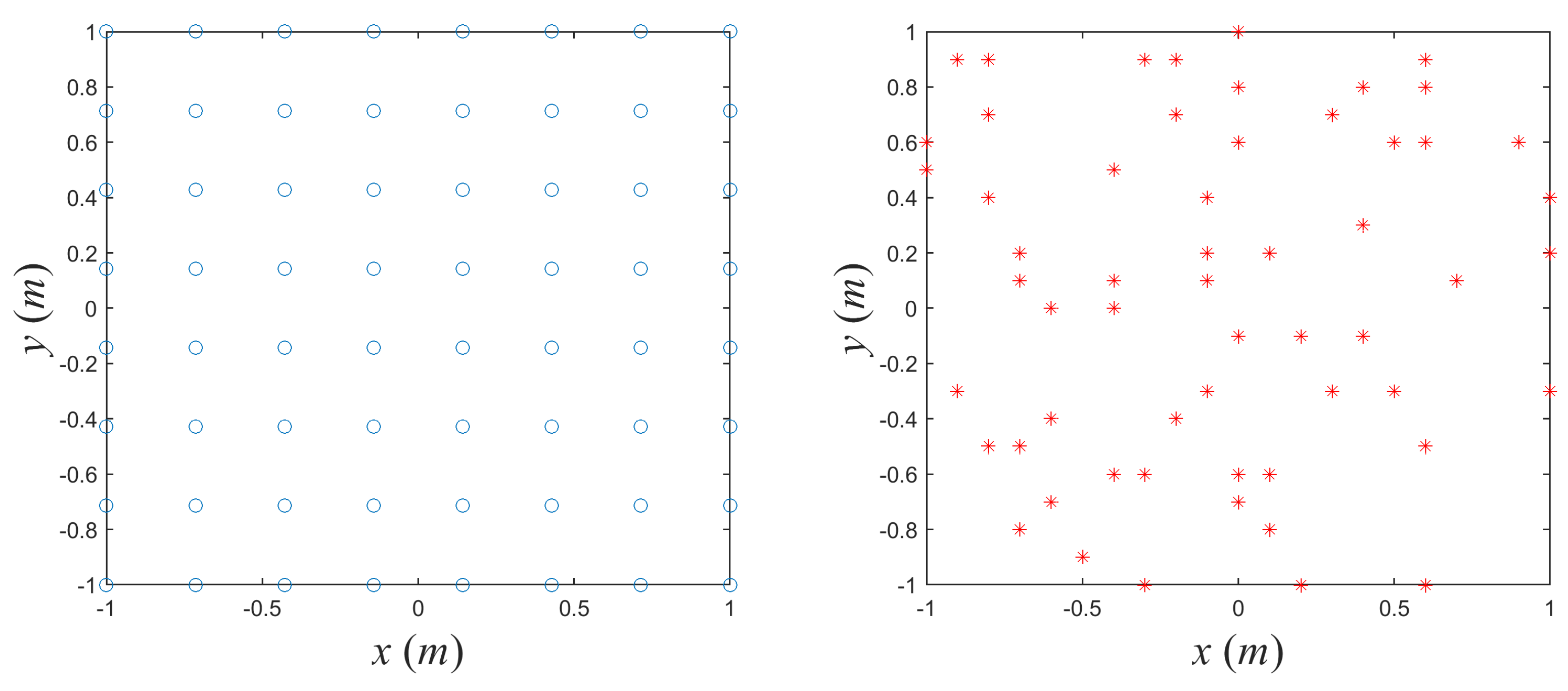

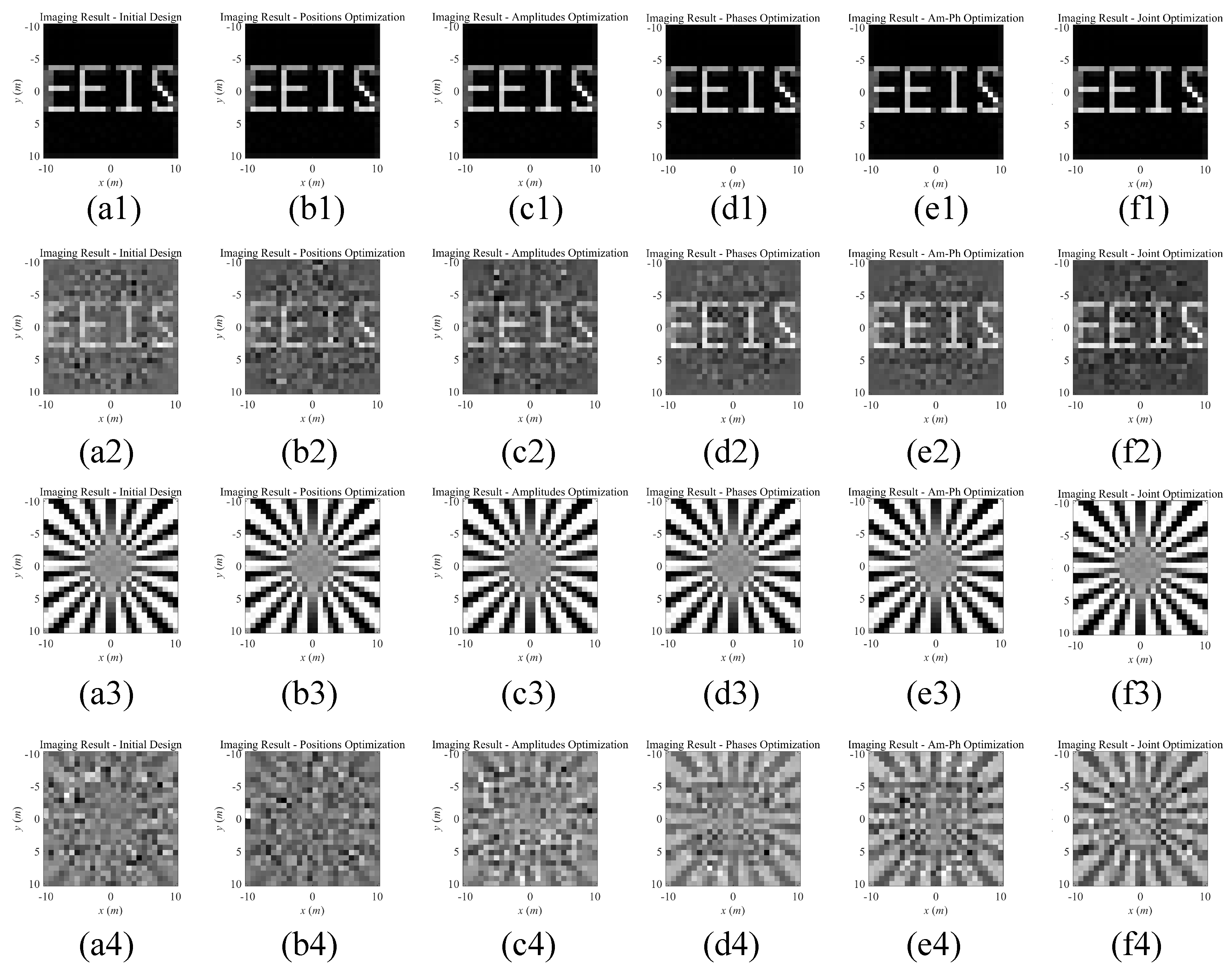
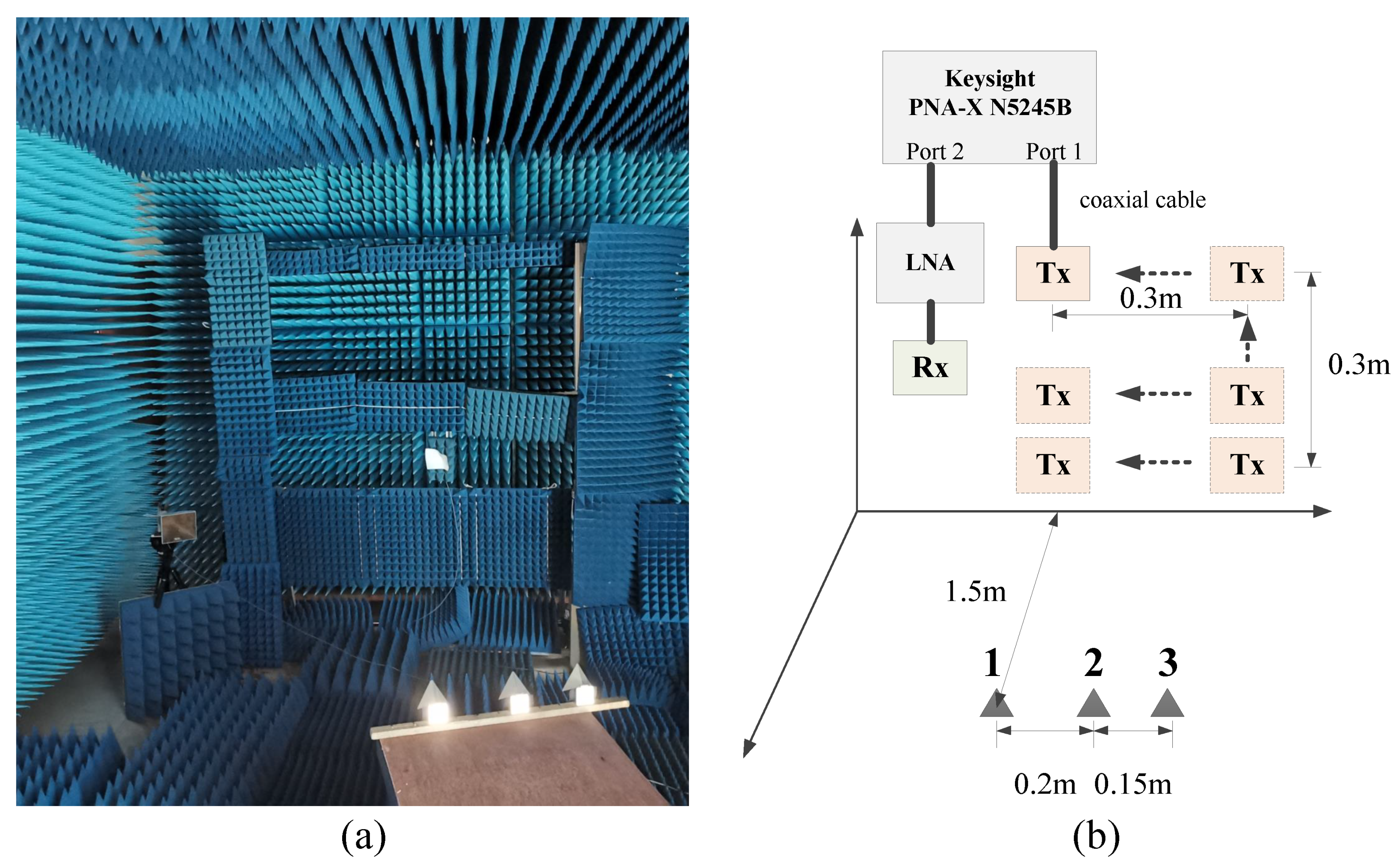
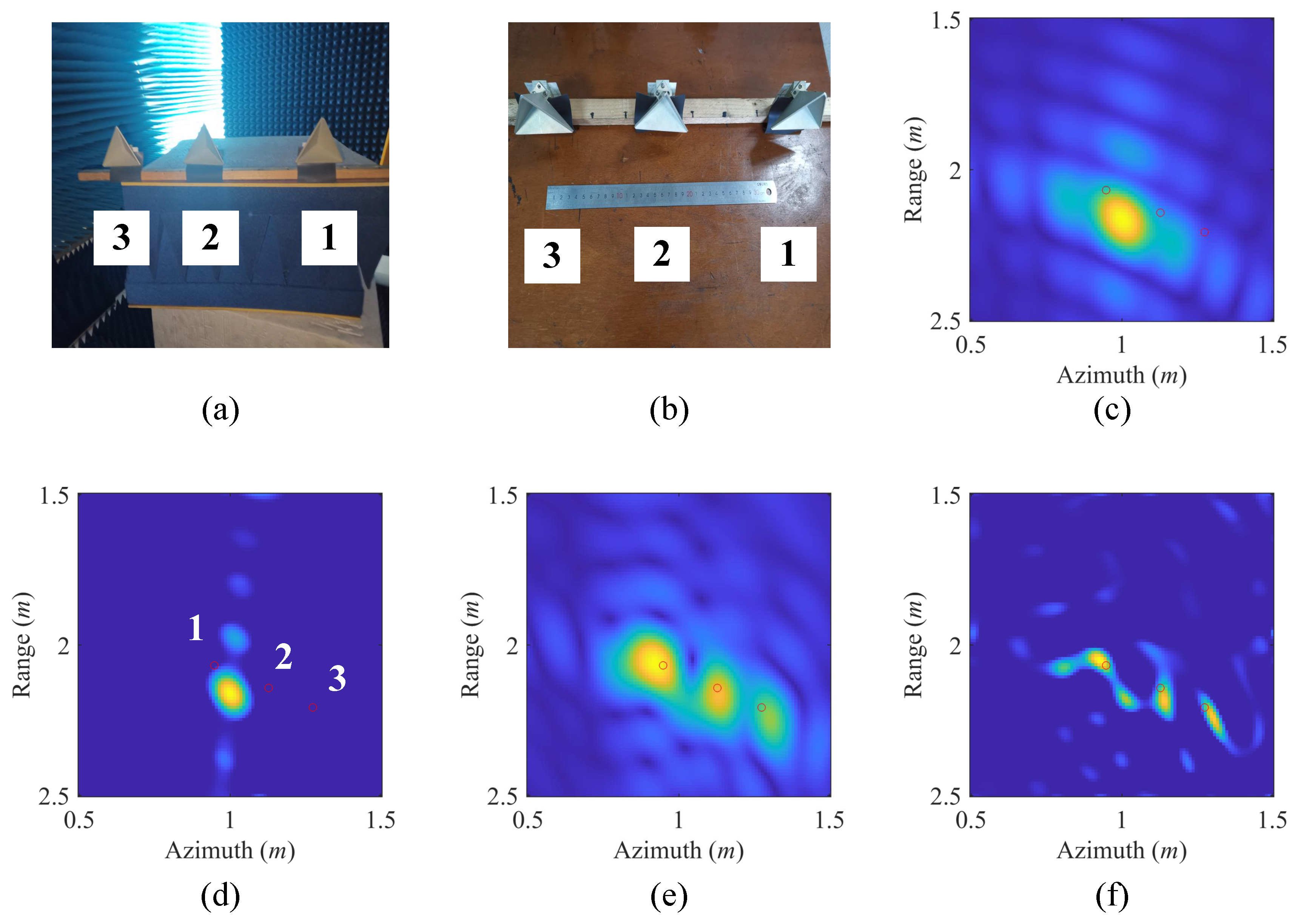
| Simulation Parameters | Values |
|---|---|
| Transmitting array size | 1 m × 1 m |
| Center position of transmitting array | (0 m, 0 m, 0 m) |
| Position of receiver | (1 m, 0 m, 0 m) |
| Number of transmitters | 16 |
| Array configuration | Uniform |
| Vertical imaging distance | 100 m |
| Frequency band | 9.5 GHz–10.5 GHz |
| Imaging region size | 10 m × 10 m |
| Grid size | 0.4 m |
| Simulation Parameters | Values |
|---|---|
| Transmitting array size | 2 m × 2 m |
| Center position of transmitting array | (0 m, 0 m, 0 m) |
| Position of receiver | (1 m, 0 m, 0 m) |
| Number of transmitters | 64 |
| Array configuration | Uniform |
| Vertical imaging distance | 100 m |
| Frequency band | 9.5 GHz–10.5 GHz |
| Imaging region size | 20 m × 20 m |
| Grid size | 0.8 m |
| Designs | Target1 | Target2 | ||
|---|---|---|---|---|
| Noise-Free | 20 dB | Noise-Free | 20 dB | |
| Initial design | dB | dB | dB | dB |
| Optimized positions | dB | dB | dB | dB |
| Optimized amplitudes | dB | dB | dB | dB |
| Optimized phases | dB | dB | dB | dB |
| Optimized amplitudes and phases | dB | dB | dB | dB |
| All-joint Optimization | dB | dB | dB | dB |
Publisher’s Note: MDPI stays neutral with regard to jurisdictional claims in published maps and institutional affiliations. |
© 2020 by the authors. Licensee MDPI, Basel, Switzerland. This article is an open access article distributed under the terms and conditions of the Creative Commons Attribution (CC BY) license (http://creativecommons.org/licenses/by/4.0/).
Share and Cite
Zhang, J.; Yuan, B.; Jiang, Z.; Guo, Y.; Wang, D. Microwave Staring Correlated Imaging Method Based on Steady Radiation Fields Sequence. Sensors 2020, 20, 6859. https://doi.org/10.3390/s20236859
Zhang J, Yuan B, Jiang Z, Guo Y, Wang D. Microwave Staring Correlated Imaging Method Based on Steady Radiation Fields Sequence. Sensors. 2020; 20(23):6859. https://doi.org/10.3390/s20236859
Chicago/Turabian StyleZhang, Jianlin, Bo Yuan, Zheng Jiang, Yuanyue Guo, and Dongjin Wang. 2020. "Microwave Staring Correlated Imaging Method Based on Steady Radiation Fields Sequence" Sensors 20, no. 23: 6859. https://doi.org/10.3390/s20236859
APA StyleZhang, J., Yuan, B., Jiang, Z., Guo, Y., & Wang, D. (2020). Microwave Staring Correlated Imaging Method Based on Steady Radiation Fields Sequence. Sensors, 20(23), 6859. https://doi.org/10.3390/s20236859





